 In 2011, gluten was recognized as having a specific link to celiac disease, and some consumers hoping to minimize the symptoms of celiac disease have opted to modify their diets. This is the second of a three-part series of publications called “Being Smart about Gluten and Gluten-Free Issues.” The purpose of this publication is to supply retailers and consumers with easy-to-understand information about labeling as related to gluten-free products. This 3-page fact sheet was written by Abigail Dicks, Amy Harder, and Amy Simonne, and published by the UF Department of Agricultural Education and Communication, September 2014.
In 2011, gluten was recognized as having a specific link to celiac disease, and some consumers hoping to minimize the symptoms of celiac disease have opted to modify their diets. This is the second of a three-part series of publications called “Being Smart about Gluten and Gluten-Free Issues.” The purpose of this publication is to supply retailers and consumers with easy-to-understand information about labeling as related to gluten-free products. This 3-page fact sheet was written by Abigail Dicks, Amy Harder, and Amy Simonne, and published by the UF Department of Agricultural Education and Communication, September 2014.
http://edis.ifas.ufl.edu/wc153
Tag: Agricultural Education and Communication Department
The Savvy Survey #3: Successful Sampling
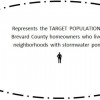 As part of the Savvy Survey series, this publication provides Extension faculty with an overview of topics to consider when thinking about who should be surveyed. Topics in this publication include understanding the survey population, constructing the sampling frame, recognizing who exists outside the population of interest, and defining the sample. This 5-page fact sheet also provides insight on issues such as over-coverage and error that can arise because of poor sampling procedures. Written by Glenn D. Israel and Jessica L. Gouldthorpe, and published by the UF Department of Agricultural Education and Communication, October 2013.
As part of the Savvy Survey series, this publication provides Extension faculty with an overview of topics to consider when thinking about who should be surveyed. Topics in this publication include understanding the survey population, constructing the sampling frame, recognizing who exists outside the population of interest, and defining the sample. This 5-page fact sheet also provides insight on issues such as over-coverage and error that can arise because of poor sampling procedures. Written by Glenn D. Israel and Jessica L. Gouldthorpe, and published by the UF Department of Agricultural Education and Communication, October 2013.
http://edis.ifas.ufl.edu/pd063
Water Issues in Florida: How Extension Can Facilitate Stakeholder Engagement and Involvement
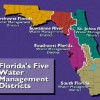 This 6-page fact sheet is a brief description of recent discussions and policies surrounding water management, use, and quality in Florida. The goal of this publication is to provide brief, but clear, information about the trends in policies that can be used by Extension agents to increase educated conversations about water issues. Water in Florida is a contested issue, and Extension agents may be called upon as a source of unbiased information by the public. Having an understanding of important agricultural and natural resources issues in Florida, including water, can help facilitate conversation, raise awareness, and lead to informed decision making. Written by Erica Odera, Alexa Lamm, Tracy Irani, Hannah Carter, and Sebastian Galindo-Gonzalez, and published by the UF Department of Agricultural Education and Communication, December 2013.
This 6-page fact sheet is a brief description of recent discussions and policies surrounding water management, use, and quality in Florida. The goal of this publication is to provide brief, but clear, information about the trends in policies that can be used by Extension agents to increase educated conversations about water issues. Water in Florida is a contested issue, and Extension agents may be called upon as a source of unbiased information by the public. Having an understanding of important agricultural and natural resources issues in Florida, including water, can help facilitate conversation, raise awareness, and lead to informed decision making. Written by Erica Odera, Alexa Lamm, Tracy Irani, Hannah Carter, and Sebastian Galindo-Gonzalez, and published by the UF Department of Agricultural Education and Communication, December 2013.
http://edis.ifas.ufl.edu/wc151
The Savvy Survey #4: Details in the Design
 As part of the Savvy Survey Series, this publication provides an overview of important facets of the survey process. Topics covered include modes for collecting responses, strategies for contacting clients and personalizing contacts, and tips for using incentives. The ability of a survey to gather accurate and useful information for assessing program needs or evaluating program outcomes is greatly influenced by the survey’s design. Careful attention to detail is essential. This 4-page fact sheet was written by Glenn D. Israel and Jessica L. Gouldthorpe, and published by the UF Department of Agricultural Education and Communication, October 2013.
As part of the Savvy Survey Series, this publication provides an overview of important facets of the survey process. Topics covered include modes for collecting responses, strategies for contacting clients and personalizing contacts, and tips for using incentives. The ability of a survey to gather accurate and useful information for assessing program needs or evaluating program outcomes is greatly influenced by the survey’s design. Careful attention to detail is essential. This 4-page fact sheet was written by Glenn D. Israel and Jessica L. Gouldthorpe, and published by the UF Department of Agricultural Education and Communication, October 2013.
http://edis.ifas.ufl.edu/pd064
Using Audience Commitment to Increase Behavior Changes in Sustainable Landscaping
 Participants in an Extension rain barrel workshop who said they would inspect their irrigation systems might begin to see themselves as people who use water wisely. Their perception of themselves as conservationists is strengthened with each new action. That makes them more likely to agree to an action that leads to an even bigger water savings. Research has shown that commitments can increase the percentage of people who will adopt a new behavior and give up an old one. This 4-page fact sheet was written by Laura A. Sanagorski and Paul Monaghan, and published by the UF Department of Agricultural Education and Communication, September 2013.
Participants in an Extension rain barrel workshop who said they would inspect their irrigation systems might begin to see themselves as people who use water wisely. Their perception of themselves as conservationists is strengthened with each new action. That makes them more likely to agree to an action that leads to an even bigger water savings. Research has shown that commitments can increase the percentage of people who will adopt a new behavior and give up an old one. This 4-page fact sheet was written by Laura A. Sanagorski and Paul Monaghan, and published by the UF Department of Agricultural Education and Communication, September 2013.
http://edis.ifas.ufl.edu/wc154
The Savvy Survey #2: Using Surveys in Everyday Extension Programming
 This second publication in the Savvy Survey Series provides Extension faculty with additional information about using surveys in their everyday Extension programming. The publication suggests how surveys can be used in needs and assets assessments to inform program development, as formative and summative evaluations to support program improvement, and as customer service tools to capture satisfaction within programming efforts. This publication also introduces the concept of using logic models to guide questionnaire development, while also discussing general data types (demographics, factual information, attitudes and opinions, behaviors and events). This 5-page fact sheet was written by Glenn D. Israel and Jessica L. Gouldthorpe, and published by the UF Department of Agricultural Education and Communication, October 2013.
This second publication in the Savvy Survey Series provides Extension faculty with additional information about using surveys in their everyday Extension programming. The publication suggests how surveys can be used in needs and assets assessments to inform program development, as formative and summative evaluations to support program improvement, and as customer service tools to capture satisfaction within programming efforts. This publication also introduces the concept of using logic models to guide questionnaire development, while also discussing general data types (demographics, factual information, attitudes and opinions, behaviors and events). This 5-page fact sheet was written by Glenn D. Israel and Jessica L. Gouldthorpe, and published by the UF Department of Agricultural Education and Communication, October 2013.
http://edis.ifas.ufl.edu/pd062
Incorporating Individual Teachings (aka Individual Contact Teaching Methods) into a Sustainable Landscaping Extension Plan of Work and Report of Accomplishment
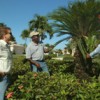 Many horticultural Extension professionals conduct numerous consulting phone calls, send e-mails, visit offices, conduct research, and visit landscapes to solve horticultural problems and concerns. Although many Extension faculty members are initially unaware that they are educating clients when providing these services, these activities shouldbe considered major educational methods. The activities should also be planned by Extension faculty and reported in an Extension plan of work and in their annual report of accomplishments. When planned thoughtfully, communicated clearly, and evaluated appropriately, these methods of individual contact teaching can become a substantial part of an Extension program. This 4-page fact sheet was written by Laura Sanagorski, and published by the UF Department of Agricultural Education and Communication, November 2013.
Many horticultural Extension professionals conduct numerous consulting phone calls, send e-mails, visit offices, conduct research, and visit landscapes to solve horticultural problems and concerns. Although many Extension faculty members are initially unaware that they are educating clients when providing these services, these activities shouldbe considered major educational methods. The activities should also be planned by Extension faculty and reported in an Extension plan of work and in their annual report of accomplishments. When planned thoughtfully, communicated clearly, and evaluated appropriately, these methods of individual contact teaching can become a substantial part of an Extension program. This 4-page fact sheet was written by Laura Sanagorski, and published by the UF Department of Agricultural Education and Communication, November 2013.
http://edis.ifas.ufl.edu/wc157
Repackaging as a Strategy to Increase Efficiency in Extension Programs
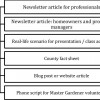 Repackaging is a way to reuse the research and writing one has done on a particular topic by formatting it in multiple formats for several audiences. It can be used as a strategy to reach a greater variety of audiences with fewer resources. This 3-page fact sheet was written by Laura A. Sanagorski, and published by the UF Department of Agricultural Education and Communication, October 2013.
Repackaging is a way to reuse the research and writing one has done on a particular topic by formatting it in multiple formats for several audiences. It can be used as a strategy to reach a greater variety of audiences with fewer resources. This 3-page fact sheet was written by Laura A. Sanagorski, and published by the UF Department of Agricultural Education and Communication, October 2013.
http://edis.ifas.ufl.edu/wc155
Improving Behavioral Outcomes in Extension Using the Tools of Community-Based Social Marketing (CBSM)
 There is increasing evidence that, with the right approach, people can be encouraged to change. From recycling, composting, and picking up pet waste to saving water, the public is adopting new behaviors and giving up old ones. The tools to do this can be found in Community Based Social Marketing (CBSM). This 6-page fact sheet was written by Paul Monaghan and Martha Monroe, and published by the UF Department of Agricultural Education and Communication, September 2013.
There is increasing evidence that, with the right approach, people can be encouraged to change. From recycling, composting, and picking up pet waste to saving water, the public is adopting new behaviors and giving up old ones. The tools to do this can be found in Community Based Social Marketing (CBSM). This 6-page fact sheet was written by Paul Monaghan and Martha Monroe, and published by the UF Department of Agricultural Education and Communication, September 2013.
http://edis.ifas.ufl.edu/wc149
Inclusion of Diverse Learners in the Educational System
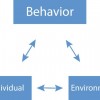 Every student in the United States has the right to an education. But not every student is ready, prepared, or willing to learn. Teachers trying to fully engage students in the learning environment can find it difficult when working with students from diverse backgrounds. Forms of diversity such as socioeconomic status, ethnicity/race, learning style, cognitive ability, gender, and ability to process and store knowledge can cause an “achievement gap” between students. This 4-page fact sheet highlights effective educational strategies for engaging students in the learning environment and assisting in closing achievement gaps. Written by Eric D. Rubenstein and Andrew C. Thoron, and published by the UF Department of Agricultural Education and Communication, July 2013.
Every student in the United States has the right to an education. But not every student is ready, prepared, or willing to learn. Teachers trying to fully engage students in the learning environment can find it difficult when working with students from diverse backgrounds. Forms of diversity such as socioeconomic status, ethnicity/race, learning style, cognitive ability, gender, and ability to process and store knowledge can cause an “achievement gap” between students. This 4-page fact sheet highlights effective educational strategies for engaging students in the learning environment and assisting in closing achievement gaps. Written by Eric D. Rubenstein and Andrew C. Thoron, and published by the UF Department of Agricultural Education and Communication, July 2013.
http://edis.ifas.ufl.edu/wc150
Persuasion as a Communication Tool
 Think about a time when you wanted your parents to do something for you, such as buy you a special birthday gift, let you stay up late, or go out with your friends. Your attempts at persuasion probably focused on communicating specific reasons why your parents should take the action you wanted. Persuasion is a communication tool that can be adjusted to convince a single person, or to move an entire audience to a desired action. In this publication you will learn several techniques for persuasive communication. This 2-page fact sheet was written by Laura Gorham, Ricky Telg, and Tracy Irani, and published by the UF Department of Agricultural Education and Communication, July 2013.
Think about a time when you wanted your parents to do something for you, such as buy you a special birthday gift, let you stay up late, or go out with your friends. Your attempts at persuasion probably focused on communicating specific reasons why your parents should take the action you wanted. Persuasion is a communication tool that can be adjusted to convince a single person, or to move an entire audience to a desired action. In this publication you will learn several techniques for persuasive communication. This 2-page fact sheet was written by Laura Gorham, Ricky Telg, and Tracy Irani, and published by the UF Department of Agricultural Education and Communication, July 2013.
http://edis.ifas.ufl.edu/wc144
Persuasion in Messages
 Specific contextual cues are added to media messages that persuade people to think one way or another about an issue and influence their actions. In this publication, you will learn the different ways that the mass media use persuasion and how persuasion encourages the audience to change their attitudes or behavior. This 3-page fact sheet was written by Laura Gorham, Ricky Telg, and Tracy Irani, and published by the UF Department of Agricultural Education and Communication, July 2013.
Specific contextual cues are added to media messages that persuade people to think one way or another about an issue and influence their actions. In this publication, you will learn the different ways that the mass media use persuasion and how persuasion encourages the audience to change their attitudes or behavior. This 3-page fact sheet was written by Laura Gorham, Ricky Telg, and Tracy Irani, and published by the UF Department of Agricultural Education and Communication, July 2013.
http://edis.ifas.ufl.edu/wc145
Persuasive Papers, Speeches, and Campaigns
 Persuasion can be used in written essays, speeches or as part of media campaigns that attempt to influence an audience to change their thinking or behavior. This publication will familiarize you with the tools necessary to develop a persuasive essay, speech, or media campaign. This 3-page fact sheet was written by Laura Gorham, Ricky Telg, and Tracy Irani, and published by the UF Department of Agricultural Education and Communication, July 2013.
Persuasion can be used in written essays, speeches or as part of media campaigns that attempt to influence an audience to change their thinking or behavior. This publication will familiarize you with the tools necessary to develop a persuasive essay, speech, or media campaign. This 3-page fact sheet was written by Laura Gorham, Ricky Telg, and Tracy Irani, and published by the UF Department of Agricultural Education and Communication, July 2013.
http://edis.ifas.ufl.edu/wc146
Planning Special Events
 Learning how to plan special events is an important skill that can benefit you and your organization. This publication is designed to help you understand what special events are and how to conduct them. After reading this publication, you will be able to explain how event sites are chosen, what criteria are used to plan events, and how to handle site permits, contracts, and budgets. You also will learn the five critical stages in planning a special event and how to evaluate an event. This 6-page fact sheet was written by Reba Ellen Hicks, Ricky Telg, and Tracy Irani, and published by the UF Department of Agricultural Education and Communication, July 2013.
Learning how to plan special events is an important skill that can benefit you and your organization. This publication is designed to help you understand what special events are and how to conduct them. After reading this publication, you will be able to explain how event sites are chosen, what criteria are used to plan events, and how to handle site permits, contracts, and budgets. You also will learn the five critical stages in planning a special event and how to evaluate an event. This 6-page fact sheet was written by Reba Ellen Hicks, Ricky Telg, and Tracy Irani, and published by the UF Department of Agricultural Education and Communication, July 2013.
http://edis.ifas.ufl.edu/wc147
Event Marketing and Public Relations
 Marketing your event so that people know about it and are motivated to attend is extremely important. The five P’s of marketing – product, promotion, price, place (location), and public relations – must be taken into consideration in order to have an event that is well attended. This 2-page fact sheet was written by Reba Ellen Hicks, Ricky Telg, and Tracy Irani, and published by the UF Department of Agricultural Education and Communication, July 2013.
Marketing your event so that people know about it and are motivated to attend is extremely important. The five P’s of marketing – product, promotion, price, place (location), and public relations – must be taken into consideration in order to have an event that is well attended. This 2-page fact sheet was written by Reba Ellen Hicks, Ricky Telg, and Tracy Irani, and published by the UF Department of Agricultural Education and Communication, July 2013.
http://edis.ifas.ufl.edu/wc148
The Savvy Survey #5: The Process for Developing Survey Questions
 A useful process for developing a high-quality questionnaire follows four steps. Brainstorm questions on a topic. Review the literature for concepts, questions, and indices. Collect ideas for questions and wording choices through focus groups or key informant interviews. And select questions linked to a program’s logic model. Each of these steps is discussed in this 3-page fact sheet written by Glenn D. Israel and Jessica L. Gouldthorpe, and published by the UF Department of Agricultural Education and Communication, August 2013.
A useful process for developing a high-quality questionnaire follows four steps. Brainstorm questions on a topic. Review the literature for concepts, questions, and indices. Collect ideas for questions and wording choices through focus groups or key informant interviews. And select questions linked to a program’s logic model. Each of these steps is discussed in this 3-page fact sheet written by Glenn D. Israel and Jessica L. Gouldthorpe, and published by the UF Department of Agricultural Education and Communication, August 2013.
http://edis.ifas.ufl.edu/pd065
Speaking with Policymakers About Current Issues
 The future of the agricultural and natural resource industry requires that educators, industry professionals, and policymakers work together when addressing contentious issues. However, discussing contentious issues with policymakers at the local, state, and national level is not always an easy task. Policymakers in general are busy people with many issues competing for their limited time. Once in the door, it is important to deliver strong messages in the right way for the policymaker to listen and use your information when making important decisions. This 2-page fact sheet discusses the differences between education and persuasion and when to use each, offers information on how to make presentations that will get their attention, and identifies things to avoid when visiting with a policymaker. Written by Alexa J. Lamm, and published by the UF Department of Agricultural Education and Communication, August 2013.
The future of the agricultural and natural resource industry requires that educators, industry professionals, and policymakers work together when addressing contentious issues. However, discussing contentious issues with policymakers at the local, state, and national level is not always an easy task. Policymakers in general are busy people with many issues competing for their limited time. Once in the door, it is important to deliver strong messages in the right way for the policymaker to listen and use your information when making important decisions. This 2-page fact sheet discusses the differences between education and persuasion and when to use each, offers information on how to make presentations that will get their attention, and identifies things to avoid when visiting with a policymaker. Written by Alexa J. Lamm, and published by the UF Department of Agricultural Education and Communication, August 2013.
http://edis.ifas.ufl.edu/wc152
The Savvy Survey #13: Online Surveys
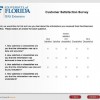 As part of the Savvy Survey Series, this publication provides Extension faculty with an overview of the process that uses email to invite participants to complete an on-line survey. This 10-page fact sheet provides guidance for constructing an online questionnaire, addressing visual design and formatting considerations, and implementing an online survey. Written by Glenn D. Israel and Jessica L. Gouldthorpe, and published by the UF Department of Agricultural Education and Communication, August 2013.
As part of the Savvy Survey Series, this publication provides Extension faculty with an overview of the process that uses email to invite participants to complete an on-line survey. This 10-page fact sheet provides guidance for constructing an online questionnaire, addressing visual design and formatting considerations, and implementing an online survey. Written by Glenn D. Israel and Jessica L. Gouldthorpe, and published by the UF Department of Agricultural Education and Communication, August 2013.
http://edis.ifas.ufl.edu/pd077
The Savvy Survey #1: Introduction
 This initial publication in the Savvy Survey Series provides Extension faculty who are interested in creating savvy surveys with a brief introduction to survey design and basic considerations to make when choosing to use a survey for program planning and evaluation. The publication also provides an introduction to and overview of the Savvy Survey Series in Appendix A. This 5-page fact sheet was written by Jessica L. Gouldthorpe and Glenn D. Israel, and published by the UF Department of Agricultural Education and Communication, August 2013.
This initial publication in the Savvy Survey Series provides Extension faculty who are interested in creating savvy surveys with a brief introduction to survey design and basic considerations to make when choosing to use a survey for program planning and evaluation. The publication also provides an introduction to and overview of the Savvy Survey Series in Appendix A. This 5-page fact sheet was written by Jessica L. Gouldthorpe and Glenn D. Israel, and published by the UF Department of Agricultural Education and Communication, August 2013.
http://edis.ifas.ufl.edu/pd061
Developing Strong Teamwork to Support Excellence in Extension Programming
 Sometimes differentiating a group from a team is difficult. Is the group of people that you work with truly a team? What benefits are there to being a member of a highly functioning team? In Patrick Lencioni’s iconic book on teamwork, The Five Dysfunctions of a Team , five elements are outlined as necessary for highly functioning teams. These are trust, ability to successfully engage in conflict, commitment to each other and the team, accountability, and focusing on collective results. This 2-page fact sheet was written by Hannah Carter, Amy Harder, and Kevan Lamm, and published by the UF Department of Agricultural Education and Communication, May 2013.
Sometimes differentiating a group from a team is difficult. Is the group of people that you work with truly a team? What benefits are there to being a member of a highly functioning team? In Patrick Lencioni’s iconic book on teamwork, The Five Dysfunctions of a Team , five elements are outlined as necessary for highly functioning teams. These are trust, ability to successfully engage in conflict, commitment to each other and the team, accountability, and focusing on collective results. This 2-page fact sheet was written by Hannah Carter, Amy Harder, and Kevan Lamm, and published by the UF Department of Agricultural Education and Communication, May 2013.
http://edis.ifas.ufl.edu/wc143